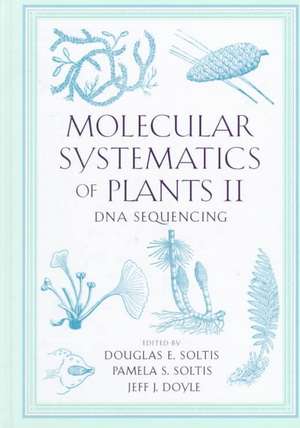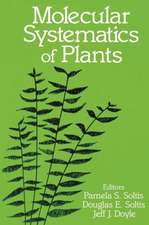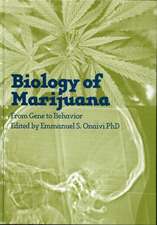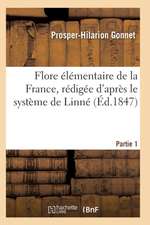Molecular Systematics of Plants II: DNA Sequencing
Autor Pamela Soltis, J.J. Doyleen Limba Engleză Hardback – 29 iun 1998
Molecular Systematics of Plants II summarizes these recent achievements in plant molecular systematics. Like its predecessor, this completely revised work illustrates the potential of DNA markers for addressing a wide variety of phylogenetic and evolutionary questions. The volume provides guidance in choosing appropriate techniques, as well as appropriate genes for sequencing, for given levels of systematic inquiry. More than a review of techniques and previous work, Molecular Systematics of Plants II provides a stimulus for developing future research in this rapidly evolving field.
Molecular Systematics of Plants II is not only written for systematists (faculty, graduate students, and researchers), but also for evolutionary biologists, botanists, and paleobotanists interested in reviewing current theory and practice in plant molecular systematics.
| Toate formatele și edițiile | Preț | Express |
|---|---|---|
| Paperback (1) | 1644.20 lei 6-8 săpt. | |
| Springer Us – 30 oct 1999 | 1644.20 lei 6-8 săpt. | |
| Hardback (1) | 1652.43 lei 6-8 săpt. | |
| Springer Us – 29 iun 1998 | 1652.43 lei 6-8 săpt. |
Preț: 1652.43 lei
Preț vechi: 2015.16 lei
-18% Nou
Puncte Express: 2479
Preț estimativ în valută:
316.39€ • 329.46$ • 262.50£
316.39€ • 329.46$ • 262.50£
Carte tipărită la comandă
Livrare economică 14-28 februarie
Preluare comenzi: 021 569.72.76
Specificații
ISBN-13: 9780412111211
ISBN-10: 0412111217
Pagini: 574
Ilustrații: XIII, 574 p.
Dimensiuni: 178 x 254 x 32 mm
Greutate: 1.23 kg
Ediția:1998
Editura: Springer Us
Colecția Springer
Locul publicării:New York, NY, United States
ISBN-10: 0412111217
Pagini: 574
Ilustrații: XIII, 574 p.
Dimensiuni: 178 x 254 x 32 mm
Greutate: 1.23 kg
Ediția:1998
Editura: Springer Us
Colecția Springer
Locul publicării:New York, NY, United States
Public țintă
ResearchDescriere
In the five years since the publication of Molecular Systematics of Plants, the field of molecular systematics has advanced at an astonishing pace. This period has been marked by a volume of new empirical data and advances in theoretical and analytical issues related to DNA. Comparative DNA sequencing, facilitated by the amplification of DNA via the polymerase chain reaction (PCR), has become the tool of choice for molecular systematics. As a result, large portions of the Molecular Systematics of Plants have become outdated.
Molecular Systematics of Plants II summarizes these recent achievements in plant molecular systematics. Like its predecessor, this completely revised work illustrates the potential of DNA markers for addressing a wide variety of phylogenetic and evolutionary questions. The volume provides guidance in choosing appropriate techniques, as well as appropriate genes for sequencing, for given levels of systematic inquiry. More than a review of techniques and previous work, Molecular Systematics of Plants II provides a stimulus for developing future research in this rapidly evolving field.
Molecular Systematics of Plants II is not only written for systematists (faculty, graduate students, and researchers), but also for evolutionary biologists, botanists, and paleobotanists interested in reviewing current theory and practice in plant molecular systematics.
Molecular Systematics of Plants II summarizes these recent achievements in plant molecular systematics. Like its predecessor, this completely revised work illustrates the potential of DNA markers for addressing a wide variety of phylogenetic and evolutionary questions. The volume provides guidance in choosing appropriate techniques, as well as appropriate genes for sequencing, for given levels of systematic inquiry. More than a review of techniques and previous work, Molecular Systematics of Plants II provides a stimulus for developing future research in this rapidly evolving field.
Molecular Systematics of Plants II is not only written for systematists (faculty, graduate students, and researchers), but also for evolutionary biologists, botanists, and paleobotanists interested in reviewing current theory and practice in plant molecular systematics.
Cuprins
Preface. 1. Choosing an Approach and an Appropriate Gene for Phylogenetic Analysis; D.E. Soltis, P.S. Soltis. 2. Contributions of PCR-based Methods to Plant Systematics and Evolutionary Biology; A.D. Wolfe, A. Liston. 3. Comparative Utility of Chloroplast DNA Restriction Site and DNA Sequence Data for Phylogenetic Studies in Plants; R.K. Jansen, et al. 4. Homology in Molecular Phylogenetics: A Parsimony Perspective; J.J. Doyle, J.I. Davis. 5. Maximum Likelihood as an Alternative to Parsimony for Inferring Phylogeny Using Nucleotide Sequence Data; P.O. Lewis. 6. Patterns of Sequence Evolution and Implications for Parsimony Analysis of Chloroplast DNA; R.G. Olmstead, et al. 7. Molecular Evolution of 18S rDNA in Angiosperms: Implications for Character Weighting in Phylogenetic Analysis; P.S. Soltis, D.E. Soltis. 8. Molecular Phylogenetic and Evolutionary Studies of Parasitic Plants; D.L. Nickrent, et al. 9. Estimating Rate and Time in Molecular Phylogenies: Beyond the Molecular Clock? M.J. Sanderson. 10. Phylogenetic Incongruence: Window into Genome History and Molecular Evolution; J.F. Wendel, J.J. Doyle. 11. Assessing Congruence: Empirical Examples from Molecular Data; L.A. Johnson, D.E. Soltis. 12. Ontogenetic Systematics, Molecular Developmental Genetics, and the Angiosperm Petal; V.A. Albert, et al. 13. The Origin and Evolution of Plastids and their Genomes; J.D. Palmer, C.F. Delwiche. 14. Molecular Phylogenetic Insights on the Origin and Evolution of Oceanic Island Plants; B.G. Baldwin, et al. 15. Molecular Markers, Gene Flow, and Natural Selection; M.L. Arnold, S.K. Emms. 16. Genetic Mapping as a Tool for Studying Speciation; L.H. Rieseberg. 17. A Perspective on the Contribution of Plastid rbcL DNA Sequences to Angiosperm Phylogenetics; M.W. Chase, V.A. Albert. 18. Molecular Systematics of the Green Algae; R.L. Chapman, et al. 19. Phylogenetic Studies of Extant Pteridophytes; P.G. Wolf, et al. Index.
Recenzii
`This is a very useful handbook for university teachers and it is also a good textbook for graduate students in systematics.'
trends in plant science, 4:6 (1999)
`The success of Molecular Systematics of Plants (P. Soltis, et al, 1992), which is the precursor of this volume, is indicated by the fact that my paperback copy has recently split into two down the spine after seven years of hard consultation ... The theoretical chapters are excellent. ... I would like to report that I anticipate my copy of this book will also break down the spine through over-use. ... The editors and authors deserve congratulations for the excellence of this book ... I suspect that chapters in this book will provide the backbone of the burgeoning discipline of molecular systematics for the next few years.'
Edinburgh Journal of Botany, 57:1 (2000)
trends in plant science, 4:6 (1999)
`The success of Molecular Systematics of Plants (P. Soltis, et al, 1992), which is the precursor of this volume, is indicated by the fact that my paperback copy has recently split into two down the spine after seven years of hard consultation ... The theoretical chapters are excellent. ... I would like to report that I anticipate my copy of this book will also break down the spine through over-use. ... The editors and authors deserve congratulations for the excellence of this book ... I suspect that chapters in this book will provide the backbone of the burgeoning discipline of molecular systematics for the next few years.'
Edinburgh Journal of Botany, 57:1 (2000)



















